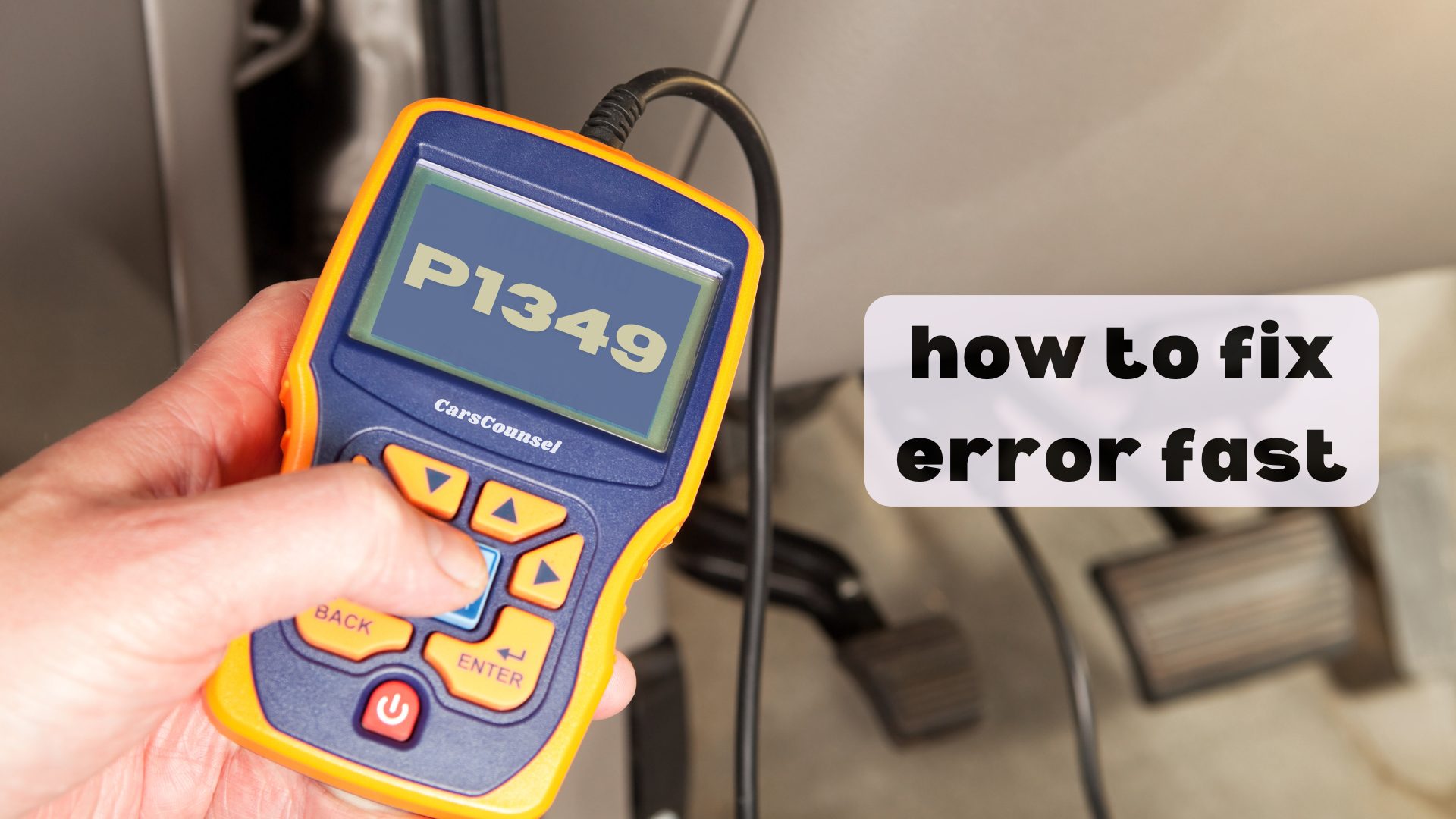As the saying goes, “when the going gets tough, the tough get going,” but what happens when your car’s engine starts to sputter and stall? If you’ve recently encountered the mysterious P1349 code, you’re not alone.
This trouble code signals a malfunction in the Variable Valve Timing system on Bank 1 of your engine, but what does that even mean? Is it a faulty solenoid or something more sinister? The good news is that you’ve taken the first step in solving the puzzle; now, it’s time to uncover the root cause of the problem and get your engine running smoothly again.

Quick Navigation
Key Takeaways
- The P1349 code is triggered when the onboard computer detects a malfunction in the Variable Valve Timing (VVT) system on Bank 1 of the engine.
- A faulty VVT solenoid or actuator, low engine oil levels, engine overheating, and wiring or electrical issues are common causes of the P1349 code.
- Symptoms of the P1349 code include rough idling, stalling, loss of power, decreased fuel efficiency, and the illuminated check engine light.
- Diagnosing the P1349 code requires specialized VVT diagnosis tools, engine performance analysis, and inspecting VVT system components for damage or wear.
- Repairing the VVT system may involve replacing faulty parts, checking engine oil levels, cleaning or replacing clogged oil passages, and regular VVT maintenance.
Understanding Code P1349
When your vehicle’s onboard computer detects a malfunction in the Variable Valve Timing (VVT) system on Bank 1 of the engine, it triggers the P1349 code, illuminating the check engine light.
The VVT system plays a vital role in fine-tuning engine performance by adjusting the timing of the opening and closing of the intake and exhaust valves.
This adjustment enables your engine to operate efficiently under various driving conditions, ensuring peak fuel efficiency and reduced emissions.
A malfunctioning VVT system can lead to poor engine performance, reduced fuel economy, and increased emissions.
Causes of VVT System Malfunction
A faulty Variable Valve Timing (VVT) solenoid or actuator is a common culprit behind the P1349 code, as it can disrupt the VVT system’s ability to adjust valve timing.
When this happens, your engine’s performance suffers. You’ll want to investigate other potential causes, too.
Some common culprits include:
- Low engine oil levels or poor oil quality, which can lead to oil filter clogs and restricted oil passages
- Engine overheating, which can cause the VVT system to malfunction
- Wiring or electrical issues in the VVT system, which can disrupt signal transmission and cause the system to fail
Identifying P1349 Symptoms
By the time the P1349 code triggers the check engine light, you may have already noticed some telltale signs of trouble.
Your engine might be rough idling, stalling, or hesitating when you accelerate. You might’ve experienced a loss of power or acceleration, or felt the engine surging or misfiring. Decreased fuel efficiency could also be a sign that something’s amiss.
These symptoms can be unsettling, but they’re vital hints to help you identify the issue. Remember, the P1349 code is related to a malfunction in the Variable Valve Timing system on Bank 1 of your engine.
Pay attention to these warning signs, and you’ll be one step closer to fixing the problem.
Diagnosing the P1349 Code
Precision is key when diagnosing the P1349 code, as it’s essential to identify the root cause of the Variable Valve Timing system malfunction.
You’ll need to use specialized VVT diagnosis tools to analyze the system’s operation and pinpoint the problem.
When conducting engine performance analysis, look for signs of faulty VVT solenoid or actuator operation, low engine oil pressure, or restricted oil passages.
Be sure to:
- Retrieve and record any diagnostic trouble codes (DTCs) using an OBD-II scanner
- Inspect the VVT system components for damage or wear
- Check the engine oil level and quality, and perform an oil change if necessary
Repairing the VVT System
With the diagnosis complete, it’s time to begin repairing the VVT system.
You’ll want to start by inspecting the VVT solenoid, actuator, and associated components for any signs of damage or wear. If you find any issues, you may need to replace the faulty parts. Solenoid replacement is a common fix for P1349 codes.
Additionally, check the engine oil level and quality, and perform an oil change if necessary. Clean or replace any clogged or restricted oil passages to guarantee proper VVT system operation.
Regular VVT maintenance can help prevent future issues. By addressing these potential problems, you can confirm your engine’s performance and efficiency.
Cost and Additional Information
Typically, the cost to fix a P1349 code malfunction can range from $200 to $600, including parts and labor, depending on the extent of the necessary repairs.
You’ll want to get a detailed shop estimate to determine the exact cost for your specific vehicle. Keep in mind that labor rates vary based on location, vehicle make and model, and engine type.
- Check local rates for a more precise estimate, as rates in metropolitan areas or at dealerships may be higher, while independent shops often charge less.
- Consider purchasing repair insurance to help cover the cost of unexpected repairs.
- Be sure to ask about any warranties or guarantees on the repairs, and what’s included in the total cost.
Preventing Future VVT Issues
To minimize the risk of future VVT issues, you should regularly check and maintain your engine’s oil level and quality, as low oil levels or poor oil quality can cause VVT system malfunctions.
Regular maintenance is key to preventing VVT problems. You should stick to the recommended oil change intervals to certify the VVT system operates smoothly.
Additionally, check your owner’s manual for specific guidelines on oil type, viscosity, and change intervals. By following these simple steps, you can reduce the likelihood of VVT system failures and related issues, such as poor engine performance, decreased fuel efficiency, and increased emissions.
Importance of Prompt Repair
One delayed repair can lead to a cascade of problems, making it essential to address the P1349 code promptly.
You don’t want to risk engine neglect, which can lead to more severe timing consequences down the road.
By putting off repairs, you’re opening yourself up to a world of potential issues that can be costly and time-consuming to fix.
- Increased engine wear and tear, leading to premature component failure
- Decreased fuel efficiency, resulting in higher fuel costs
- Poor engine performance, making your vehicle less reliable and less enjoyable to drive
More OBD-II Codes
Frequently Asked Questions
Can a Malfunctioning VVT System Cause Long-Term Engine Damage?
If you neglect a malfunctioning VVT system, it can lead to long-term engine damage, increased oil consumption, and degraded engine performance, as the system’s inability to optimize valve timing can cause excessive wear on engine components.
Will a P1349 Code Affect My Vehicle’s Emissions Test Results?
You’re likely to fail emissions tests with flying colors – or rather, failing miserably – if your vehicle’s VVT system is malfunctioning, as it’ll skyrocket test failure rates and violate stringent emissions standards, putting your vehicle’s environmental footprint in the hot seat.
Can I Drive My Vehicle Safely With a P1349 Code Illuminated?
You can drive your vehicle with a P1349 code, but exercise caution as it may lead to decreased performance, rough idling, and poor fuel efficiency. Be aware of vehicle limitations and take driving precautions to avoid stalling or further damage.
Are VVT System Repairs Typically Covered Under Warranty?
You should check your vehicle’s warranty status to see if VVT system repairs are covered; typically, they’re included during the standard warranty period, but extended coverage may vary depending on the manufacturer and your specific plan.
Can a P1349 Code Be Triggered by Other Engine Issues?
As you rev up your engine, imagine a symphony of moving parts. But what if the conductor, your VVT system, falters? A faulty sensor or ignition issue can trigger the code, so investigate these potential culprits before diving into VVT repairs.
Conclusion
As you shift into gear, don’t let the P1349 code put the brakes on your engine’s performance. Remember, a faulty VVT system is like a ticking time bomb, waiting to trigger a chain reaction of problems that can leave you stranded on the side of the road. Don’t wait for the other shoe to drop – address the issue promptly to avoid costly repairs and get your engine purring like new again.

